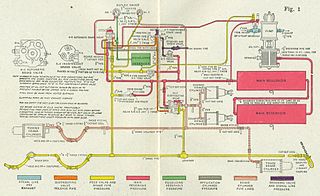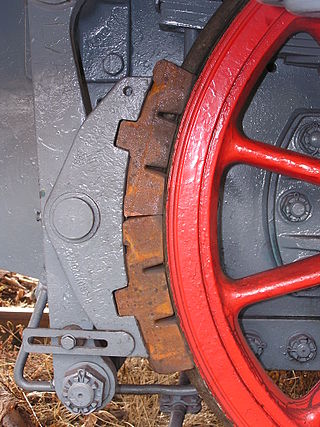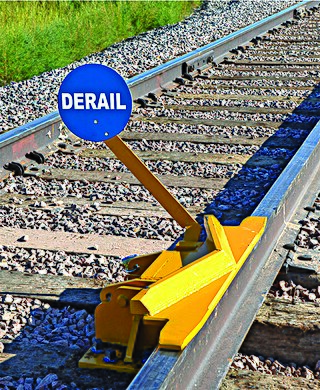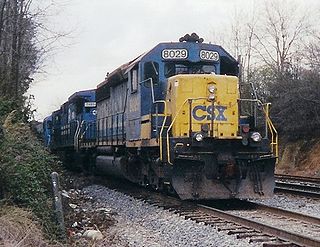Related Research Articles

A railway air brake is a railway brake power braking system with compressed air as the operating medium. Modern trains rely upon a fail-safe air brake system that is based upon a design patented by George Westinghouse on April 13, 1869. The Westinghouse Air Brake Company was subsequently organized to manufacture and sell Westinghouse's invention. In various forms, it has been nearly universally adopted.

A train wreck, train collision, train accident or train crash is a type of disaster involving one or more trains. Train wrecks often occur as a result of miscommunication, as when a moving train meets another train on the same track; or an accident, such as when train wheels come off a track in a derailment; or when a boiler explosion occurs. Train wrecks have often been widely covered in popular media and in folklore.

A railway brake is a type of brake used on the cars of railway trains to enable deceleration, control acceleration (downhill) or to keep them immobile when parked. While the basic principle is similar to that on road vehicle usage, operational features are more complex because of the need to control multiple linked carriages and to be effective on vehicles left without a prime mover. Clasp brakes are one type of brakes historically used on trains.

On March 15, 1999, Amtrak's southbound City of New Orleans passenger train collided with a semi-trailer truck in the village of Bourbonnais, Illinois, United States. Most of the train derailed, killing eleven people. A National Transportation Safety Board (NTSB) investigation into the accident attributed the cause to the truck driver trying to beat the train across a grade crossing. The NTSB's recommendations from the accident included increased enforcement of grade crossing signals, the installation of train event recorders at all new or improved grade crossings, and procedures to provide emergency responders with accurate lists of all crew members and passengers aboard trains. The city of Bourbonnais erected a memorial near the site to commemorate those killed in the accident.
Classification of railway accidents, both in terms of cause and effect, is a valuable aid in studying rail accidents to help to prevent similar ones occurring in the future. Systematic investigation for over 150 years has led to the railways' excellent safety record.

The San Bernardino train disaster, was a combination of two separate but related incidents that occurred in San Bernardino, California, United States: a runaway train derailment on May 12, 1989; and the subsequent failure on May 25, 1989, of the Calnev Pipeline, a petroleum pipeline adjacent to the tracks which was damaged by earth-moving equipment during the crash cleanup.

A derail or derailer is a device used to prevent fouling of a rail track by unauthorized movements of trains or unattended rolling stock. The device works by derailing the equipment as it rolls over or through it.
There have been a number of train accidents on the railway network of Victoria, Australia. Some of these are listed below.

The CSX 8888 incident, also known as the Crazy Eights incident, was a runaway train event involving a CSX Transportation freight train in the U.S. state of Ohio on May 15, 2001. Locomotive #8888, an EMD SD40-2, was pulling a train of 47 cars, including some loaded with hazardous chemicals, and ran uncontrolled for just under two hours at up to 51 miles per hour (82 km/h). It was finally halted by a railroad crew in a second locomotive, which caught up with the runaway train and coupled their locomotive to the rear car.
References
- ↑ "Runaway Indian train travels 70km without driver". BBC. February 26, 2024.
- ↑ "Zug in Bayern außer Kontrolle: Verdacht richtet sich gegen Lokführer". Merkur. September 28, 2019.
- ↑ "Cairo Train Driver Left Brakes Off". BBC News . February 28, 2019.
- ↑ "BHP counts cost of runaway ore train derailment after suspending rail operations". ABC News. November 5, 2018. Archived from the original on September 10, 2019.
- ↑ Mouneshwar Sonnad (November 9, 2017). "Driver chases runaway engine on his bike, stops it after 13km". The Times of India .
- ↑ "Untersuchungsbericht Entgleisung von Z 43144 zwischen den Hst Gries und St. Jodok am 22. Dezember 2017" (PDF). 2018.
- ↑ "Belgian runaway train prompts alert". BBC News. February 19, 2016.
- ↑ Huffstutter, P.J. (July 8, 2013). "Insight: How a train ran away and devastated a Canadian town". Reuters . Retrieved July 9, 2013.
- ↑ Archived at Ghostarchive and the Wayback Machine : "Accident tren IL Caragiale Dambovita iulie 2012 VEZI IMAGINI DE LA ACCIDENT". YouTube .
- ↑ "Zugunglück am Arlberg: Bremssystem versagte". Die Presse. June 17, 2010. Retrieved March 2, 2021.
- ↑ "DR Congo crash toll 'passes 100'". BBC News. August 2, 2007. Retrieved May 22, 2010.
- ↑ "Der Geisterzug von Spiez". September 7, 2019. Retrieved March 2, 2021.
- ↑ "Schlussbericht zum Unfall eines Dienstzuges der BLS in Dürrenast (Thun)". September 10, 2020. Retrieved March 2, 2021.
- ↑ Wojciech Trzmiel; Antoni Trzmiel. "Jeleśnia zróbcie coś, bo nie mam hamowania". Wolna Droga (in Polish). Archived from the original on December 3, 2017.
{{cite journal}}: CS1 maint: multiple names: authors list (link) - ↑ "CNN.com - Human error blamed for runaway train". CNN . June 26, 2003. Retrieved April 23, 2018.
- ↑ Runaway of Suburban Electric Passenger Train 5264 and collision with Diesel Locomotive Hauled Passenger Train 8141 Australian Transport Safety Bureau October 2003
- ↑ David Patch (November 12, 2010). "At times, 'Unstoppable' goes off track from reality". Toledo Blade.
- ↑ Kohlin, Ron. "CSX 8888 Runaway Investigation". Kohlin. Retrieved February 18, 2015.
- ↑ "Un tren sin maquinista descontrolado por la Línea Urquiza". Clarín (in Spanish). May 6, 1999.
- ↑ The Colorado Springs Runaway 30 years later, archived from the original on December 12, 2021, retrieved January 5, 2020
- ↑ Collision and Derailment of Montana Rail Link Freight Train with Locomotive Units and Hazardous Materials Release (PDF) (Report). National Transportation Safety Board. December 6, 1989. RAR-89-05.
- ↑ "Die Geisterfahrt des ET 420". OVB Heimatzeitungen. December 31, 2018. Retrieved March 2, 2021.
- ↑ "Runaway - Arbitration Case of Wesley MacDonald". www.cwrr.com. December 17, 1987.
- ↑ "Nepisiguit Junction". Traingeek - Trains and Photography.
- ↑ "Runaway Engine on the Main Line!". Popular Science. October 1961. Retrieved September 23, 2018.
- ↑ "Archivbilder: Der Zugunfall von Wädenswil". SRF. May 18, 2006.
- ↑ "A Wreck at Asheboro". Charlotte Observer . Charlotte, NC. January 23, 1898. p. 8. Retrieved October 26, 2015– via Newspapers.com.

- ↑ Winston Daily Journal (January 27, 1898). "A Horrible Accident on the Asheboro & Aberdeen Railroad". Webster's Weekly. Reidsville, NC. p. 2. Retrieved October 26, 2015– via Newspapers.com.
